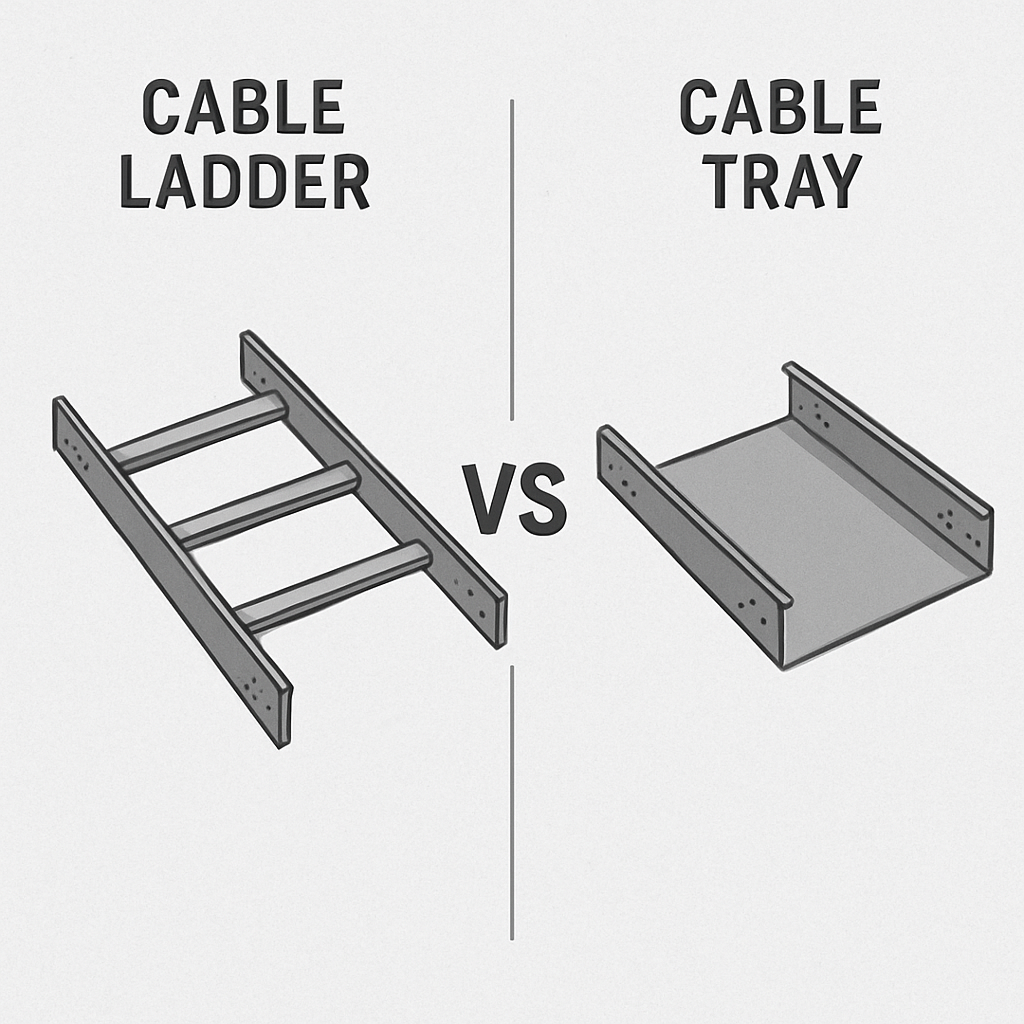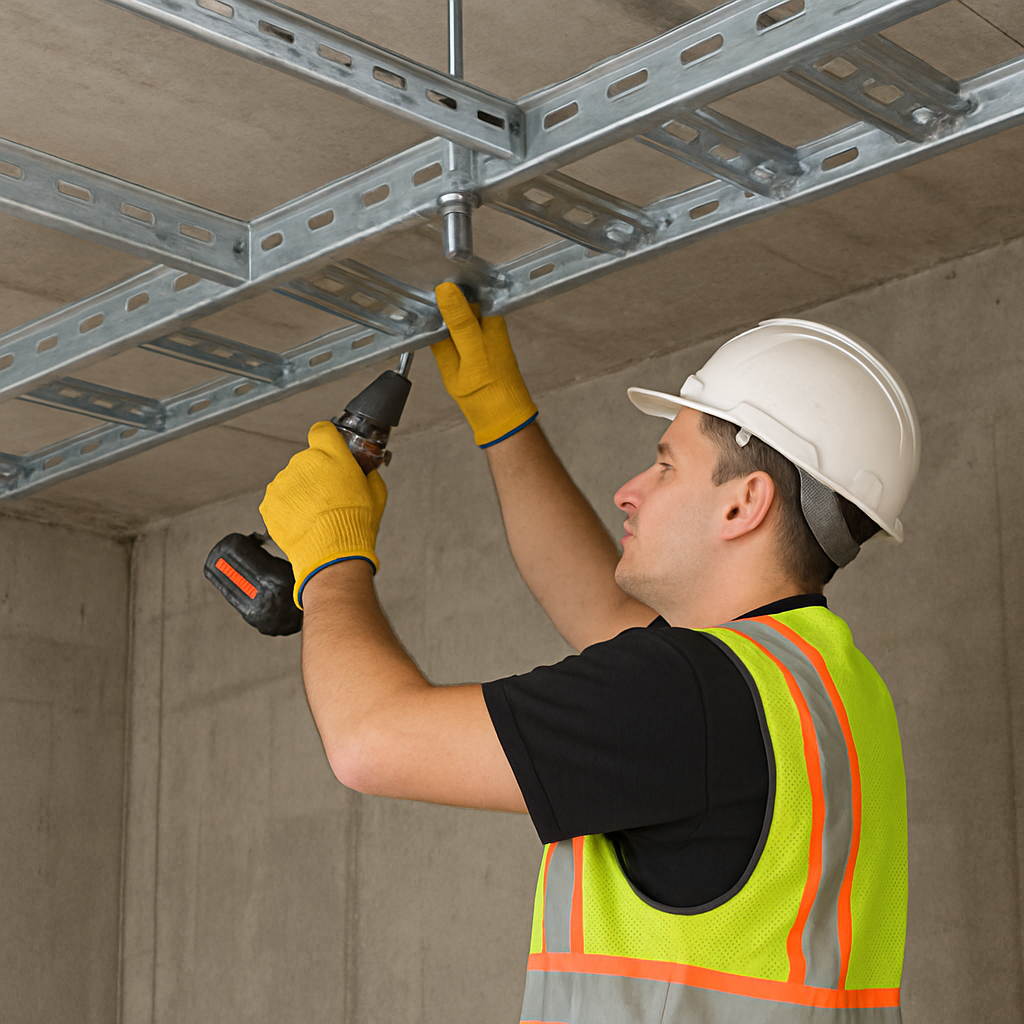A cable ladder system is a fundamental component in the realm of electrical infrastructure, providing an organized, secure, and accessible pathway for cables and wires within commercial, industrial, and sometimes residential spaces. This extensive guide delves deeply into the concept of cable ladders, exploring their origins, types, benefits, installation procedures, regulatory requirements, and various applications across different sectors.
Understanding Cable Ladders
A cable ladder, also known as a cable tray or wireway, is a modular, open-frame structure designed to house and manage multiple electrical cables, power lines, communication cables, and other wiring systems. It typically consists of two parallel side rails with evenly spaced cross-members (rungs) that form a ladder-like configuration. These components are commonly fabricated from durable materials like steel, aluminum, stainless steel, or fiber-reinforced plastic (FRP), ensuring resistance against corrosion, mechanical stress, and environmental hazards.

Types of Cable Ladders
1. Standard Cable Ladders: Ideal for general-purpose installations where loads are moderate, these come in straight lengths that can be easily joined using fittings such as bends, tees, and couplers.
2. Heavy-Duty Cable Ladders: Designed for high-capacity cable management in heavy industries or harsh environments, they feature thicker gauge metals and wider rungs to accommodate larger cable bundles without deformation.
3. Perforated Cable Trays: Similar to standard cable ladders but featuring perforations on the base or sides, these allow for better ventilation, heat dissipation, and drainage, reducing the risk of overheating and prolonging cable life.
4. Covered or Enclosed Cable Ladders: For enhanced protection against dust, debris, and accidental contact, these systems have covers or lids that can be clipped, bolted, or hinged onto the main frame.
5. Modular Cable Ladders: Offering flexibility and adaptability, modular systems consist of pre-engineered sections that can be assembled and disassembled quickly to meet changing needs.
6. Adjustable Height Cable Ladders: These units have adjustable height supports, allowing for leveling and accommodating uneven surfaces or floor penetrations.
7. Non-Metallic Cable Ladders: Suitable for environments sensitive to electromagnetic interference (EMI), they are made of non-conductive materials like FRP or PVC.
Benefits of Using Cable Ladders
Cable Protection: Cable ladders protect cables from physical damage, abrasion, and potential exposure to harmful substances.
Fire Safety: They promote fire safety by allowing heat to dissipate more efficiently and preventing the spread of flames through cable congestion.
Efficient Organization: Cable ladders enable easy organization and segregation of cables based on function, facilitating maintenance, repair, and upgrades.
Flexibility and Scalability: Their modular design allows for quick and simple modifications as the electrical system evolves over time.
Cost-Efficiency: By consolidating cables and simplifying installation processes, cable ladders often reduce material costs and labor expenses compared to conduit systems.
Design and Installation Considerations
1. Load Capacity: Before selecting a cable ladder, calculate the total weight of all installed and future cables to ensure the chosen system can support the load.
2. Spacing and Support: Optimal spacing between rungs should cater to the diameter and quantity of cables while maintaining proper support. Also, install adequate supports and bracing according to manufacturer recommendations and local regulations.
3. Routing and Accessibility: Plan the cable ladder route to avoid obstructions, minimize bending radius, and maintain accessibility for inspection and maintenance.
4. Fittings and Accessories: Use appropriate accessories including bends, tees, reducers, expansion joints, and clamps to construct a stable and compliant cable ladder system.
5. Regulatory Compliance: Adhere to national and international standards such as NEC (National Electrical Code) in the United States, IEC (International Electrotechnical Commission) guidelines, and relevant building codes for safety, performance, and fire-resistance.
Applications of Cable Ladders
Industrial Plants: Managing large-scale power distribution networks, control systems, and automation circuits in manufacturing plants, factories, and warehouses.
Commercial Buildings: Organizing data and voice communications, HVAC wiring, and power supply in office buildings, shopping centers, hospitals, hotels, and educational institutions.
Data Centers: Supporting structured cabling systems, cooling, and power delivery in mission-critical IT environments.
Outdoor Installations: Protecting and organizing utility cables, telecommunications lines, and transportation signaling systems against weather elements.
Residential Applications: Although less common, cable ladders may find use in advanced home automation systems or when managing extensive cable runs in basements or attics.

Installation Procedures
1. Site Preparation: Measure, mark, and prepare the mounting surfaces. Ensure the area is clean, dry, and free from debris.
2. Component Assembly: Assemble the cable ladder sections and accessories, taking care to align them correctly and securely fasten connections.
3. Support Placement: Position and fix supporting brackets, anchors, or suspension systems at regular intervals along the planned route, adhering to manufacturers’ specifications and local building codes.
4. Ladder Installation: Mount the cable ladder segments, starting from one end and working towards the other. Ensure stability and correct alignment during installation.
5. Cable Installation: Once the ladder is in place, carefully lay and secure cables following industry best practices for cable pulling tension, bundling, and separation.
6. Inspection and Testing: Conduct a thorough inspection and testing of the cable ladder system to verify compliance, structural integrity, and functionality.
Cable ladders are indispensable tools in modern electrical infrastructure, playing a critical role in safeguarding cables, promoting efficient energy transmission, and contributing to workplace safety. With the right selection, design, and installation, cable ladder systems optimize cable management and provide long-lasting, adaptable solutions for evolving electrical needs across diverse industries and applications. Through understanding the intricacies of cable ladder systems, professionals can make informed decisions and implement successful projects that stand the test of time.
Applications in electrical/industrial projects
When it comes to managing and organizing cables in electrical and industrial projects, choosing the right system is crucial. Among the options available, cable ladders and cable trays are two of the most common solutions. In this article, we will explore the applications, advantages, and differences between these systems to help you make informed decisions for your projects.

What is a Cable Ladder?
A cable ladder is a robust structure made of side rails connected by rungs or crossbars. It is typically used to support heavy cables in industrial environments. Aluminum cable ladders, in particular, are popular due to their lightweight and corrosion-resistant properties. Cable ladder design allows for maximum ventilation, which helps to prevent overheating of cables.
O que é uma bandeja de cabos?
Cable trays, on the other hand, are more like a trough or a channel. They can be made from various materials, including steel and aluminum, and come in different designs such as solid-bottom, ventilated, or perforated. Cable trays are ideal for supporting a large number of smaller cables and are often used in commercial buildings.
Comparing Cable Ladders and Cable Trays
When deciding between a cable ladder and a cable tray, it’s important to consider the specific needs of your project.
Key Differences
- Support Capacity: Cable ladders are better suited for heavier cables, while cable trays are ideal for lighter, smaller cables.
- Ventilation: Cable ladders offer superior ventilation, which is beneficial for heat dissipation.
- Flexibility: Cable trays provide more flexibility in terms of cable management and allow for easy additions and modifications.
- Installation: Cable ladder installation is typically quicker and more straightforward due to its open design.
Cable Ladder vs. Cable Tray

Types of Cable Ladders and Trays
Both cable ladders and trays come in various types to suit different applications.
Cable Ladder Types
- Aluminum Cable Ladder: Lightweight and resistant to corrosion, making it ideal for outdoor and industrial environments.
- Steel Cable Ladder: Offers greater strength and is suitable for heavy-duty applications.
Cable Tray Types
- Solid-Bottom Tray: Provides complete enclosure and protection for cables.
- Ventilated Tray: Has openings for airflow, useful for heat dissipation.
- Perforated Tray: Combines the benefits of solid and ventilated trays, offering protection and ventilation.
Applications of Cable Ladders and Trays
Cable ladders and trays are used in a wide range of industries and applications.
Industrial Applications
In industrial settings, cable ladder systems are often the preferred choice due to their strength and durability. They are commonly used in factories, power plants, and refineries where heavy cables are required. The open design of cable ladders also makes it easier to perform maintenance and inspections.
Commercial Applications
For commercial buildings, cable tray systems are more commonly used. They are ideal for organizing smaller cables in office buildings, shopping malls, and hospitals. Cable trays provide a tidy and organized way to manage cables, ensuring a neat appearance and reducing the risk of cable damage.
Special Applications
In some cases, a combination of cable ladders and trays may be used to accommodate different cable types and sizes. This approach allows for the benefits of both systems to be utilized in a single project.
Cable Ladder and Tray Installation
Proper installation is key to the effectiveness and safety of cable management systems.
Dicas de instalação
- Planning: Start with a detailed plan that considers the layout and routing of cables.
- Support Structures: Ensure that the support structures for the cable ladder or tray are strong enough to handle the weight of the cables.
- Spacing: Maintain adequate spacing between cables to prevent overheating and interference.
- Safety: Follow all safety guidelines and regulations during installation to protect workers and equipment.
Choosing the Right System for Your Project
When choosing between cable ladders and trays, consider factors such as cable weight, environment, and future expansion plans.
Fatores a serem considerados
- Environment: In corrosive environments, an aluminum cable ladder may be the best choice.
- Cable Type: For heavy-duty cables, a cable ladder is often more suitable.
- Flexibility: If you anticipate changes or additions to your cable system, a cable tray might offer more flexibility.
Conclusão
Understanding the applications and differences between cable ladders and trays is essential for successful electrical and industrial projects. By selecting the right system, you can ensure efficient cable management, safety, and ease of maintenance.
Both systems have their unique advantages, and the choice ultimately depends on the specific needs of your project. Whether you opt for a cable ladder system or a cable tray system, proper planning and installation will ensure a reliable and organized cable management solution.
